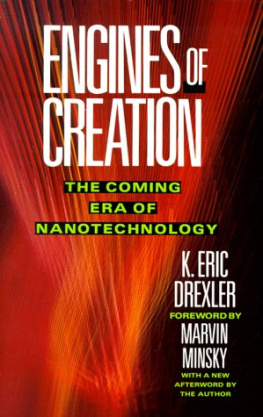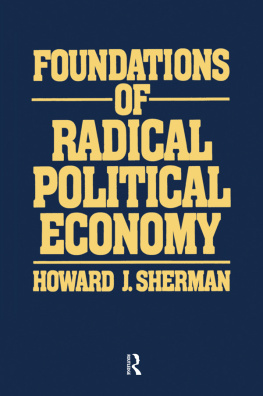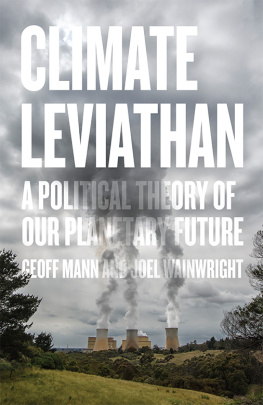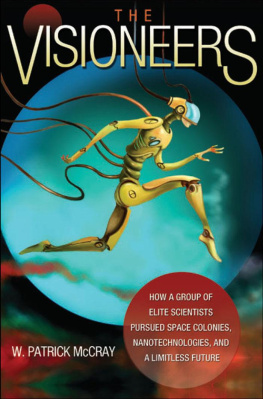RADICAL
ABUNDANCE
RADICAL
ABUNDANCE

HOW A REVOLUTION
IN NANOTECHNOLOGY WILL
CHANGE CIVILIZATION

K. ERIC DREXLER

PublicAffairs
New York
Copyright 2013 by K. Eric Drexler.
Published in the United States by PublicAffairs,
a Member of the Perseus Books Group
All rights reserved.
No part of this book may be reproduced in any manner whatsoever without written permission except in the case of brief quotations embodied in critical articles and reviews. For information, address PublicAffairs, 250 West 57th Street, Suite 1321, New York, NY 10107.
PublicAffairs books are available at special discounts for bulk purchases in the U.S. by corporations, institutions, and other organizations. For more information, please contact the Special Markets Department at the Perseus Books Group, 2300 Chestnut Street, Suite 200, Philadelphia, PA 19103, call (800) 810-4145, ext. 5000, or e-mail .
Book Design by Pauline Brown
Typeset in 11.5 point Minion Pro by the Perseus Books Group
A CIP catalog record for this book is available from the Library of Congress
ISBN 978-1-61039-114-6 (EB)
First Edition
10 9 8 7 6 5 4 3 2 1
For my friend and adviser
Arthur Kantrowitz,
who this year would be 100
CONTENTS
IMAGINE WHAT THE WORLD might be like if we were really good at making thingsbetter thingscleanly, inexpensively, and on a global scale. What if ultra-efficient solar arrays cost no more to make than cardboard and aluminum foil and laptop supercomputers cost about the same? Now add ultra-efficient vehicles, lighting, and the entire behind-the-scenes infrastructure of an industrial civilization, all made at low cost and delivered and operated with a zero carbon footprint.
If we were that good at making things, the global prospect would be, not scarcity, but unprecedented abundanceradical, transformative, and sustainable abundance. We would be able to produce radically more of what people want and at a radically lower costin every sense of the word, both economic and environmental.
This isnt the future most people expect. Over recent decades the world has been sliding toward a seemingly inevitable collision between economic development and global limits. As nations expand industrial capacity, carbon emissions rise. Expectations of resource scarcity drive wars and preparations for war as tensions grow over water from rivers, metals from Africa, oil from the Middle East, and fresh oil fields beneath the South China Sea. Everywhere progress and growth are beginning to resemble zero-sum games. The familiar, expected future of scarcity and conflict looks bleak.
These familiar expectations assume that the technology we use to produce things will remain little changed. But what if industrial production as we know it can be changed beyond recognition or replaced outright? The consequences would change almost everything else, and this new industrial revolution is visible on the horizon.
Imagine a world where the gadgets and goods that run our society are produced not in a far-flung supply chain of industrial facilities, but in compact, even desktop-scale, machines. Imagine replacing an enormous automobile factory and all of its multi-million dollar equipment with a garage-sized facility that can assemble cars from inexpensive, microscopic parts, with production times measured in minutes. Then imagine that the technologies that can make these visions real are emergingunder many names, behind the scenes, with a long road still ahead, yet moving surprisingly fast.

Nanoscale parts and atomic precision together enable atomically precise manufacturing (APM), and through this technology will open the door to extraordinary improvements in the cost, range, and performance of products. The range extends beyond the whole of modern physical technology, spanning ultra-light structures for aircraft, billion-core laptop computers, and microscopic devices for medical use, including devices able to recognize and destroy cancer cells.
Nanotechnology meant a profound revolution in production and products, and soon after 1986 the concept of nanotechnology took on a life of its own. In equal measure it sparked excitement and controversy, suggesting new research paths to the scientific community and exciting (if sometimes fantastic) futuristic visions to our popular culture. The idea of building things on the molecular level soon spurred the growth of fields of research; a decade later, these fields had grown into billion-dollar programs around the world, all devoted to studies of nanotechnology.
During the 1990s, however, public and scientific visions drifted and followed divergent paths. The futuristic popular visions floated free from reality, into realms unconnected to science, while the scientists themselves turned toward work that would bring in research funds, with a focus on short-term results. As popular expectations skewed one way and research in another, what was called nanotechnology began to seem like a hyped disappointmenta broken promise, not an emerging revolution that would reshape our world.
In recent years technology has advanced surprisingly far toward a critical threshold, a turning point on the road to APM-level technologies. While progress in atomically precise fabrication has accelerated, understanding of its implications has lagged, not only in the public at large, but also within the key research communities. Much of the most important research is seldom called nanotechnology, and this simple problem of labeling has obscured how far we have come.
Understanding matters and ignorance can be dangerous. The advent of a revolution in nanotechnology will bring capabilities that transform our world, and not in a small way. The ramifications encompass concerns on the scale of climate change, global economic development, and the gathering crises of the twenty-first century.
The revolutionary concept is simple in essence, as such things often are.
The key is to apply atomically precise nanotechnologies to build the machines we use to make things. Large scale, high-throughput atomically precise manufacturing is the heart of advanced nanotechnology, and in the coming years it has the potential to transform our world.
APM is a kind of manufacturing, but it isnt industrial manufacturing. The differences run from bottom to top and involve replacing enormous, polluting factories with clean, compact machines that can make better products with more frugal use of energy and material resources.
The Industrial and Information Revolutions can serve as models (and yardsticks) because atomically precise manufacturing will combine and amplify the features of both. What computer systems have done for processing information, APM systems will do for processing matter, providing programmable machines that are fast, inexpensive, and enormously flexiblelike computers in many ways, but rather than electronic signals, producing physical products.
Rough as it may be, the comparison to computing is useful because APM has much in common with digital electronics. The parallels range from their shared basis in fast, discrete operations to their emergent similarities in scale, speed, cost, and scope of application. Where digital electronics deals with patterns of bits, APM deals with patterns of atoms. Where digital electronics relies on nanoscale circuits, APM relies on nanoscale machinery. Where the digital revolution opened the door to a radical abundance of information products, the APM revolution will open the door to a radical abundance of physical products, and with this, a cascade of transformative consequences that history suggests will amount to a Version 2.0 of world civilization, a change as profound as the Industrial Revolution, but unfolding at Internet speeds.
Next page











